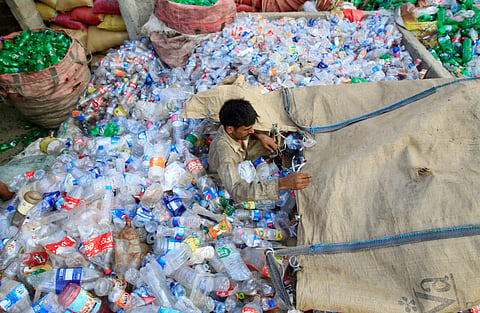We are living on a plastic planet
New studies reveal that tiny plastic fibres are everywhere, not just in our oceans but on land too

Sometimes a single revelation opens our eyes to a whole new view of the world. The contamination of tap water around the world with microplastics unmasks earth as a planet pervasively polluted with plastic.
What that means for the seven billion people who live on it, no one yet knows. All the experts can agree on is that, given the warning signs being given by life in the oceans, the need to find out is urgent.
We knew the oceans were awash with plastic. Brightly coloured and often floating, the debris from consumer society formed colossal, ugly swirls in the seas and littered even the remotest beaches from the Arctic to the deep Pacific.
But the wholesale pollution of the land was hidden. Tap water is gathered from hills, rivers, lakes and wells, sampling the environment as it goes. It turns out that tiny fibres of plastic are everywhere.
Perhaps it should not really be a surprise. Plastic is a fantastic material, flexible and — unless burned — essentially indestructible. It is so useful that it now makes up about half of all human-related waste. But while humanity has realised its benefits it has yet to realise the cost: apart from the small proportion incinerated, “the vast majority of plastic ever made is still present in the environment in some form”, according a recent scientific review . That’s more than eight billion tonnes .
The review was able to summarise what is known about the scale of microplastic contamination on land in a few words: “There is a dearth of studies.” But the tap water revelation has drawn attention to disparate pilot studies that were hinting at ubiquitous plastic pollution. All the German bottled beer tested in one lab contained microplastic, as did sugar and honey samples.
We appear to be drinking and probably eating microplastics all the time. Does it matter? No-one knows, but the research on marine plastic contamination raises cause for concern. Marine creatures that consume microplastics can be harmed by them and not just by physical obstruction.
Plastics often contain a wide range of chemicals to change their properties or colour and many of these are toxic or hormone disruptors. Plastics can attract other pollutants too, including dioxins, metals and some pesticides. Microplastics have also been shown to attract microbial pathogens.
The conditions in animal guts are also known to enhance the release of pollutants from plastics. “Further,” as the review puts is, “there is evidence that particles may even cross the gut wall and be translocated to other body tissues, with unknown consequences”.
Does any of this affect people? The only land animals in which the consumption of microplastic has been closely studied are two species of earthworm and a nematode. Another huge unanswered question is how microplastics get into our water and food. A report from the UK’s Chartered Institution of Water and Environmental Management says the biggest proportion are fibres shed by synthetic textiles and tyre dust from roads, with more from the breakdown of waste plastics. It suggests the plastic being dumped on land in Europe alone each year is between four and 23 times the amount dumped into all the world’s oceans.
A lot of the microplastic debris is washed into wastewater treatment plants, where the filtering process does capture many of the plastic fragments. But about half the resulting sludge is ploughed back on to farmland across Europe and the US, according to recent research published in the journal Environmental Science and Technology. That study estimates that up to 430,000 tonnes of microplastics could be being added to European fields each year, and 300,000 tonnes in North America.
“It is striking that transfers of microplastics — and the hazardous substances bound to them — from urban wastewater to farmland has not previously been considered by scientists and regulators,” the scientists concluded. “This calls for urgent investigation if we are to safeguard food production,” they say in a related publication.
Cities also appear prone to the extensive pollution. Another recent study, again the first to shed light on the topic, revealed a rain of microplastics falling on Paris from the air, dumping between three and 10 tonnes a year on the city. The same team found microplastics in an apartment and hotel room. A leading scientist, citing this work, says we are likely to be breathing microplastics.
Like so many environmental problems — climate change, pesticides, air pollution — the impacts only become clear years after damage has been done. If we are lucky, the plastic planet we have created will not turn out to be too toxic to life. If not, cleaning it up will be a mighty task. Dealing properly with all waste plastic will be tricky: stopping the unintentional loss of microplastics from clothes and roads even more so. But above all we need to know if we are all drinking, eating and breathing microplastic every day and what that is doing to us, and we need to know urgently.
–Guardian News & Media Ltd
Sign up for the Daily Briefing
Get the latest news and updates straight to your inbox


